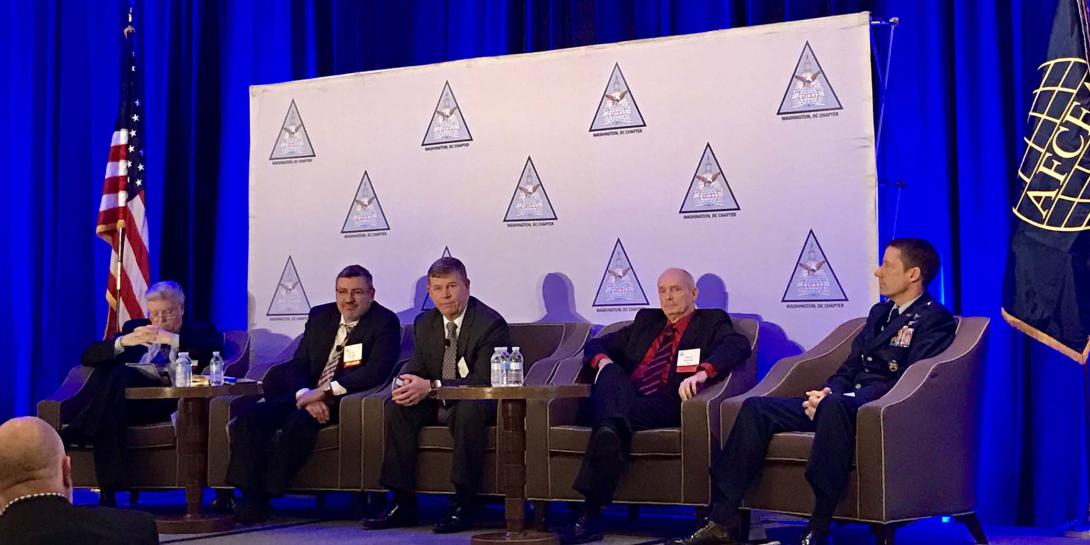Budget Woes Force DISA to Go Into 'Adoption' Mode
While years of slashed budgets and uncertain revenue streams set in motion some innovative thinking at the Defense Information Systems Agency (DISA), the crunch constricted innovation and choked off a lot of creative work the agency developed.
DISA offers little opportunity to support in-house organic solutions, relying instead much more on private companies for solutions that agency officials can then adapt to military applications, said Tony Montemarano, DISA's executive deputy director. “We are in the adoption mode now,” he shared Thursday at an AFCEA DC Chapter monthly breakfast.
“Twenty-eight years in DISA, I have never seen such budgetary limitations,” Montemarano said. “Every time we do anything at DISA, we have to come up with an innovative way of doing it. Thinking we have an extra 10 bucks sitting on the side doesn’t happen anymore. If we’re going to bring something new, we have to take something old and sunset it.
“It’s the toughest time I have ever seen in the agency,” he told the room full of industry representatives. “When you come forth with your solutions, please understand we’ve got to replace the legacy, and we’ve got to do it in a cost effective manner.”
DISA operates now in a mode of “adopt before you buy, buy before you create,” he shared. “That is really hitting our culture. We are adopting and we are buying. Very, very few things are we actually creating.” Given the fiscal constraints, procurement reform has become a “really big deal to us,” Montemarano continued, setting up his colleague Alfred Rivera, director of the Development and Business Center, to discuss the agency’s refined attention on next-generation engineering and its narrower focus on innovation and enterprise architecture.
Even though DISA is taking on more of an operational role, it still is fine-tuning its acquisition processes and prepping for its Encore III and Systems Engineering Technology Innovation (SETI) contracts for IT systems support, Rivera said. DISA plans to announce the date for what it is calling a “pre-proposal conference” to provide details on the SETI contract and answer industry questions, Rivera said. The to-be-scheduled conference will take place after the SETI request for proposal (RFP) delivery that will happen in March. SETI will be a challenging acquisition, he said, because one selection criteria will question how industry looks at innovation, Rivera said. “We’re at the point where it really makes a lot of sense in how we want to view innovation,” he offered.
The $7 billion, five-year contract will be funded by program offices to acquire technical support, he added.
Also shared during the breakfast, panelists said the agency’s enduring work on Mission Partner Environment (MPE) and information services remains in flux as officials seek counsel from combatant commanders and the joint staff on refining requirements. “I know every year you keep hearing how we’re going to put this big capability on data center virtualization on top of a virtualized network. We’re still working a lot of those efforts,” Rivera said. DISA is running pilot studies in Wiesbaden, Germany, and at the U.S. Central Command in Tampa, Florida, to determine how it might expand MPE capabilities and collapse existing stovepipe coalition environments, he offered.
As the agency builds its in-house common Department of Defense Information Network (DODIN) lab to replicate the entire DODIN, it is moving away from individual test environments. As it stands, they have 60 to 70 percent of the capability in place now, Rivera said, important information for industry because the lab will serve as a place where companies might test commercial capabilities that might become part of the DODIN infrastructure.
DISA’s best cyber defense to secure its networks so far remains the Joint Regional Environment Stack (JRSS) program, a near-term goal of the overarching Joint Information Environment (JIE) concept, Defense Department Chief Information Officer Terry Halvorsen told reporters Wednesday during a media roundtable. DISA, in increasing its role in the cyber fight, is tackling the JRSS network modernization effort that shifts from component-centric to a enterprise-wide operations and defense model.
“The pedal is down,” John Hickey, director of DISA's Cyber Development Directorate, said Thursday of JRSS. “It’s still our No. 1 cyber initiative, and we’re in the process of fueling that. The key over the next year is really training operators on that stack as they transition from a base camp and station approach to a more joint approach that gives visibility on … the Joint Force Headquarters-DODIN as well as Cyber Command.”
A portion of the mammoth network modernization effort throughout the Defense Department includes getting rid of wasteful, redundant systems, ineffective ones or those too old and costly to maintain, offered Hickey and Brig. Gen. Robert Skinner, USAF, deputy commander of JFHQ-DODIN. “We have so many tools and so many capabilities that I’m going to offer, we’re at about 50 percent of leveraging the capabilities these tools currently provide," said Gen. Skinner, who has been selected for promotion to major general.
What is needed, from an operator’s standpoint, is to function within an adversary’s OODA loop—or military parlance for the decision cycle of observe, orient, decide and act, Gen. Skinner said. “How do we get the right information at the right time?” he asked. “I’m looking for a decision-support type of capability. How can we get actionable intelligence from the entire domain up to the right levels to make a decision of how do we maneuver either the domain itself or maneuver forces within the domain to make sure that the domain is favorable to support the combatant commands as they go forward with the mission they’ve been assigned.”





Comments